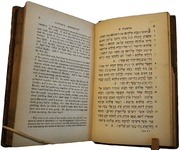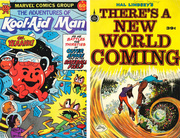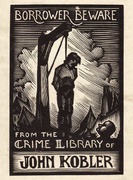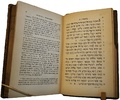
Needle-in-a-haystack stories are the caffeine of collecting. Who hasn’t heard a tale of someone finding a rare toy at a garage sale, a dust-covered antique in an attic, or a priceless document hidden inside a beat-up picture frame? “That could be me,” we are supposed to think, and right on cue, we do.
When it comes to book-collecting bonanzas, Rebecca Rego Barry has heard ’em all. As the editor of “Fine Books & Collections,” it’s actually part of her job to listen to such stories, and follow up on those that seem likely to lead to new tales of prize catches. Recently, Barry gathered more than 50 accounts of literary treasures discovered in unlikely places into a new book called Rare Books Uncovered, now available from Voyageur Press.
Barry was not always so interested in books. “I was actually more into rocks,” she says of one of her childhood passions. “I liked pretty minerals and polished stones, and there was nothing I loved more than going to the Museum of Natural History in New York and getting one of those kits with the rocks glued onto a piece of cardboard and some information about each one.”
“It’s only after you get it home and do your research that you know if you’ve hit the jackpot—or overpaid.”
A master’s in book history, which Barry calls “an extremely useless but really wonderful degree,” eventually gave her license to haunt the stacks of used-book stores and the aisles of book fairs. “I started out as a writer for ‘Fine Books & Collections'” she says of her transition from rocks to paper, “just doing a freelance article here and there. When they needed an editor about six and a half years ago, I tossed my hat into the ring and they took a chance on me. I’ve been doing it ever since.”
Unlike the subjects in her book, Rare Books Uncovered found her. “I wish I could take credit for it,” she says, “but it was really the idea of an editor named Dennis Pernu. He had done a couple of books in a similar vein on rare guitars. I guess he was brainstorming in an editorial meeting one day and said, ‘What about books? That could be really cool.’ I think he found me through my website and just figured it might be something I’d be able to do. I almost didn’t believe it when I got his email.”
Soon, Barry was mining her contact lists of booksellers and book collectors for good discovery stories. In the end, she spoke to everyone from the legendary rock guitarist turned book hunter Martin Stone—he reportedly sold Led Zeppelin’s Jimmy Page a copy of the I Ching that had been owned by occultist icon Aleister Crowley—to the author and book dealer Larry McMurtry, who typed out his book-discovery story before mailing it to Barry. “I found more people and stories than I could fit in the book,” she says.

The 1950 French-language edition of Gone with the Wind (top) is not especially rare, but only one features an original watercolor by the book’s illustrator, Emilio Grau Sala (above), inscribed to actress Vivien Leigh, who played the Scarlett O’Hara character in the 1939 film. Courtesy John Wiley, Jr.
Obviously, Stone and McMurtry made the cut. In his letter to Barry, McMurtry told her the story of the time, 25 years ago, when he bought a rare copy of “New Yorker” writer Joseph Mitchell’s first book, My Ears Are Bent, for $18. Recently, Barry found one listed online for $10,000.
McMurtry had first seen his prize in a video sent to him by a dealer from Lincoln, Nebraska, to save McMurtry the bother of visiting the store himself. Stone’s story is more of an old-fashioned adventure. Thanks to his reputation as a book scout, Stone was invited to visit the private, upper-floors of the great Tulkens bookstore in Brussels, which, in 2008, decided to liquidate its stock after being in business for roughly a century. There, Stone was shown what Barry calls “an immense collection” of books that had been carefully wrapped in brown paper in the 1930s, which means they were in immaculate condition. Many were highly sought illustrated reference books published by the English firm of A&C Black. “These were books that were just as fresh as a daisy, as though they had been published yesterday,” Barry quotes Stone as saying, “but the date was 1899 or 1903, and some of them were in multiples. It was just extraordinary.”
Most of us will never be invited to cherry-pick the best of the best from a venerable European bookstore like Stone was, but the experience of Louisiana State University history professor David Culbert is something that just about anyone can relate to—assuming you are versed in Argentine literature of the mid-20th century. In 2011, Culbert was at an estate sale in Baton Rouge where he came across a first edition of El Aleph, published in 1949 and written by Jorge Luis Borges. Culbert paid 50 cents for his copy of El Aleph, which is rather a bargain considering that first editions of this title in good condition, which Culbert’s copy was, usually fetch around $3,000. And to think that some people make jokes about how little money there is in a liberal-arts education.

Good copies of El Aleph by Jorge Luis Borges often sell for as much as $3,000, but a university history professor picked this one up at an estate sale for 50 cents. Courtesy David Culbert.
Other discoveries in Rare Books Uncovered feature more familiar titles, such as Margaret Mitchell’s Gone with the Wind, which was first published in the United States in 1936 before being made into a movie starring Clark Gable and Vivien Leigh in 1939. Probably the biggest collector of all things GWTW, as it’s often abbreviated, is John Wiley, Jr., who had long coveted a fellow collector’s 1950 French edition of the book, with its illustrations by Emilio Grau Sala. Wiley had one of these French editions, of course, but the rival collector’s copy contained an inscription to Vivien Leigh by Sala, along with a watercolor by the artist, depicting Leigh’s character, Scarlett O’Hara, dressed in green and standing in front of her home on the mythical Southern plantation of Tara.
Eventually, the owner of the French copy of Gone with the Wind put his entire collection up for auction at Christie’s, but the book was not among the individual auction items. Undeterred, Wiley placed absentee bids on several lots of books, most of which he won. When 17 banker’s boxes of books arrived at his door, Wiley was delighted to discover the French GWTW with the Sala inscription and illustration among a lot of 100 or so other foreign editions. “The Christie’s catalogers had missed it,” Barry writes.
This raises an interesting question: When one person finds a rare book, is their gain always at the expense of somebody else? “That can be true,” Barry says, “but among the booksellers I work with, especially those that belong to organizations like the ABAA or the ILAB, there’s an ethical obligation not to swindle each other or people who don’t know any better, like little old ladies selling their husband’s things. Personally, if I were to go to a garage sale and thought I had found a $5,000 book on sale for a dollar, I would feel conflicted. In most cases, though, the more common example is that you see a book you feel like you’ve seen before and decide to take a chance on it. It’s only after you get it home and do your research that you know if you’ve hit the jackpot—or overpaid.”

The words “Maurice Sendak” are not found on this 1955 boxed set of booklets published by the Anti-Defamation League, but the style of the illustrations are unmistakable. Courtesy Aleph-Bet Books.
Early in her career, Susan Benne, who is now the executive director of the ABAA, got a taste of the jackpot herself. Back in 2002, when Benne was working for an antiques-show management company in New York City, she and a friend found themselves in a used-book shop near Boston. Previously, Benne had spent a few years working for a dealer of children’s books called Aleph-Bet Books outside of New York City, so naturally she headed for that section of the bookstore. There, in a basket filled with “little things that might have gotten knocked around if left on the shelves with the larger picture books,” as Barry describes it, she noticed a small box with an illustrated cover filled with seven illustrated booklets. The box was titled Seven Little Stories on Big Subjects, and a credit at the bottom of the box’s cover identified it as being published by the “Anti-Defamation League of B’nai B’rith, 515 Madison Avenue, New York 22, NY.” The booklets inside also featured illustrated covers, and the author was credited as Gladys Baker Bond.
Thanks to her time at Aleph-Bet, Benne recognized Seven Little Stories on Big Subjects as an unsigned project from 1955 by the great Maurice Sendak, author of Where the Wild Things Are and countless other kid-lit classics. Taking her unpriced prize to the bookstore’s proprietor, she asked “How much?” Five dollars later, Benne had her Sendak, although she was not really sure what it was worth. When she later showed the box and its contents to her former bosses at Aleph-Bet, they happily took it off her hands, later rewarding her with a $1,500 finder’s fee for her sharp eye. Today, in case you are interested, you can pick up a different set of these Sendak booklets from Aleph-Bet—with a “slightly soiled” box—for $3,500.

 Digging Up the Weirdest Old Books and Comics From the Thrift-Store Bargain Bins
Digging Up the Weirdest Old Books and Comics From the Thrift-Store Bargain Bins
 From Donation Bin to Sotheby's: How a Rare 19th-Century Bible Almost Got Away
From Donation Bin to Sotheby's: How a Rare 19th-Century Bible Almost Got Away Digging Up the Weirdest Old Books and Comics From the Thrift-Store Bargain Bins
Digging Up the Weirdest Old Books and Comics From the Thrift-Store Bargain Bins When Book Lovers Guarded Their Prized Possessions With Tiny Artworks
When Book Lovers Guarded Their Prized Possessions With Tiny Artworks BooksThere's a richness to antique books that transcends their status as one of …
BooksThere's a richness to antique books that transcends their status as one of … Mari Tepper: Laying it on the Line
Mari Tepper: Laying it on the Line Nice Ice: Valerie Hammond on the Genteel Charm of Vintage Canadian Costume Jewelry
Nice Ice: Valerie Hammond on the Genteel Charm of Vintage Canadian Costume Jewelry How Jim Heimann Got Crazy for California Architecture
How Jim Heimann Got Crazy for California Architecture Modernist Man: Jock Peters May Be the Most Influential Architect You've Never Heard Of
Modernist Man: Jock Peters May Be the Most Influential Architect You've Never Heard Of Meet Cute: Were Kokeshi Dolls the Models for Hello Kitty, Pokemon, and Be@rbrick?
Meet Cute: Were Kokeshi Dolls the Models for Hello Kitty, Pokemon, and Be@rbrick? When the King of Comedy Posters Set His Surreal Sights on the World of Rock 'n' Roll
When the King of Comedy Posters Set His Surreal Sights on the World of Rock 'n' Roll How One Artist Makes New Art From Old Coloring Books and Found Photos
How One Artist Makes New Art From Old Coloring Books and Found Photos Say Cheese! How Bad Photography Has Changed Our Definition of Good Pictures
Say Cheese! How Bad Photography Has Changed Our Definition of Good Pictures Middle Earthenware: One Family's Quest to Reclaim Its Place in British Pottery History
Middle Earthenware: One Family's Quest to Reclaim Its Place in British Pottery History Fancy Fowl: How an Evil Sea Captain and a Beloved Queen Made the World Crave KFC
Fancy Fowl: How an Evil Sea Captain and a Beloved Queen Made the World Crave KFC
A couple of summers ago, I went to a library sale in a small town in Maine, and spotted a copy of The Feminine Mystique, in hardcover. Huh, I thought, that looks old. I wonder if it’s a first edition.
Indeed it was, and when I looked at the title page, it was also inscribed by Betty Friedan.
I grabbed it, and kept looking through the books. Then I found a book by Robert F. Kennedy, also hardcover first edition and inscribed.
I went through the sale and found more than a half dozen books of similar type and vintage, bought them all for a buck each, and set out to find the story. It turns out there was a minister who did a radio show where he interviewed authors in the mid-1960s, and his radio show was aired on the military network, and these books were all sent to him by people he interviewed. He was a supporter of the library and when he died a couple of years ago, apparently his books were donated to the library.
I worked at antiquarian bookshops while I was in high school and college, and then ran my own shop for a decade. Last night I spent what seemed like hours dreaming about going through shelf and shelf of books at a thrift shop looking for treasure. A frequent dream subject- even though I have been out of the business for over a decade.
I do have a basement full of books that I occasionally sift through. Last year I found a beat up copy of Green on Gambling from 1847 – I wasn’t even sure when or where I had picked it up. I sold it immediately for several hundred dollars, and heard from 2 buyers who would have paid much more.
I’ve found a number of rare and valuable books over the years, but the most improbable turned up at a library book sale a year or so ago. On a table marked “old books” I saw an elderly copy of Shaw’s MAN AND SUPERMAN. I figured the odds of its being a first edition were ridiculous, but I took a look anyhow. It wasn’t a first, of course…but it did contain a long inscription and autograph by GBS himself…
I love these stories. Some of the collectors items I have were bought when published and turned out to be collectors items later. There was a library bookseller in San Francisco in one pre-internet year where I purchased for 50 cents each a first edition of Masters and Johnson’s first book (Later sold to bookshop for $100), a worn field map of Southern Africa once owned by big game hunger Leslie Simpson (Donated to the California Academy of Sciences) and a pre-WWII color postal map of China, values at about $2500. Library sales are not like that anymore!
I can’t compete with these wonderful stories, but I have a favorite one about my own book collecting. I collect vintage school books (primarily readers, although I have many other subjects as well). I like the editions of the 30s, 40s and 50s. The Dick and Jane readers are probably the most popular and sought after, and thus, the most pricey. A few years ago I was visiting my favorite thrift store, which is run by senior citizens. They have a fabulous book department, curated by a lovely gentleman who takes great care to organize and arrange the books so they can be easily viewed. As usual, I went first to the children’s section, looked down at the bottom shelf, and saw an almost complete set of the Scott-Foresman Dick and Jane readers from 1951, in near mint condition. (One of the 6th grade readers was missing). I snagged them for $5. The missing title was easily found on eBay, and now I have my lovely books. The set goes for about $300. Not a fortune, but out of my price range!
what can you tell me about my bookSilver Chief dog of the north? By Jack O’Brien circa 1947.
Also, The Nature Library BIRDS circa 1917 – 1926. Full color illustrations.
Thank you in advance.
2 years ago, my friend and i bidded on a lot comprised of a wooden artist’s flat file because i needed one through a local auction house, we got it for a mere $50, which, to our surprise, when we got there they came packed to the brim with high quality art supplies.
As we were packing, someone else who bought the rest of the contents of the bedroom asked if we would like to take 2 bookshelves of books off their hands because it would be us taking or they take them to the landfill as they were after the furniture.
They looked like great art books and a bunch of children’s books, we thought, aww…shame if they were tossed, so we took them. Turns out, that entire estate of books were owned by the late Patricia Weissman, who was an engraver and calligrapher for Steuben Glass! Amongst the books were 2 signed and inscribed Maurice Sendak titles, a book inscribed by Helen Frankenthaler, Babar the King signed by the english translator, a limited edition, numbered, signed copy of Carmen by the illustrator, and many many more, not to mentioned original artworks, letters beautifully scribed, original engravings and templates designed for Steuben Glass, photographs, fountain pens, rare first edition children’s books, many signed and inscribed, stacks of types and fonts and calligraphy, and curiously 4 stacks of folios filled with the book’s dust jackets in pristine condition!!
Till this day i held on to many of the books and ephemeras.
Was wondering about eye opener magazines and Captain billy whiz bang Magazines. These magazines are from around 1926 to mid 1930’s. I have bout 50 eye openers and 25 whiz bangs and a few other ones. Can u tell me what there worth and would like to get them into useful hands there in great shape. Thank you
great story!